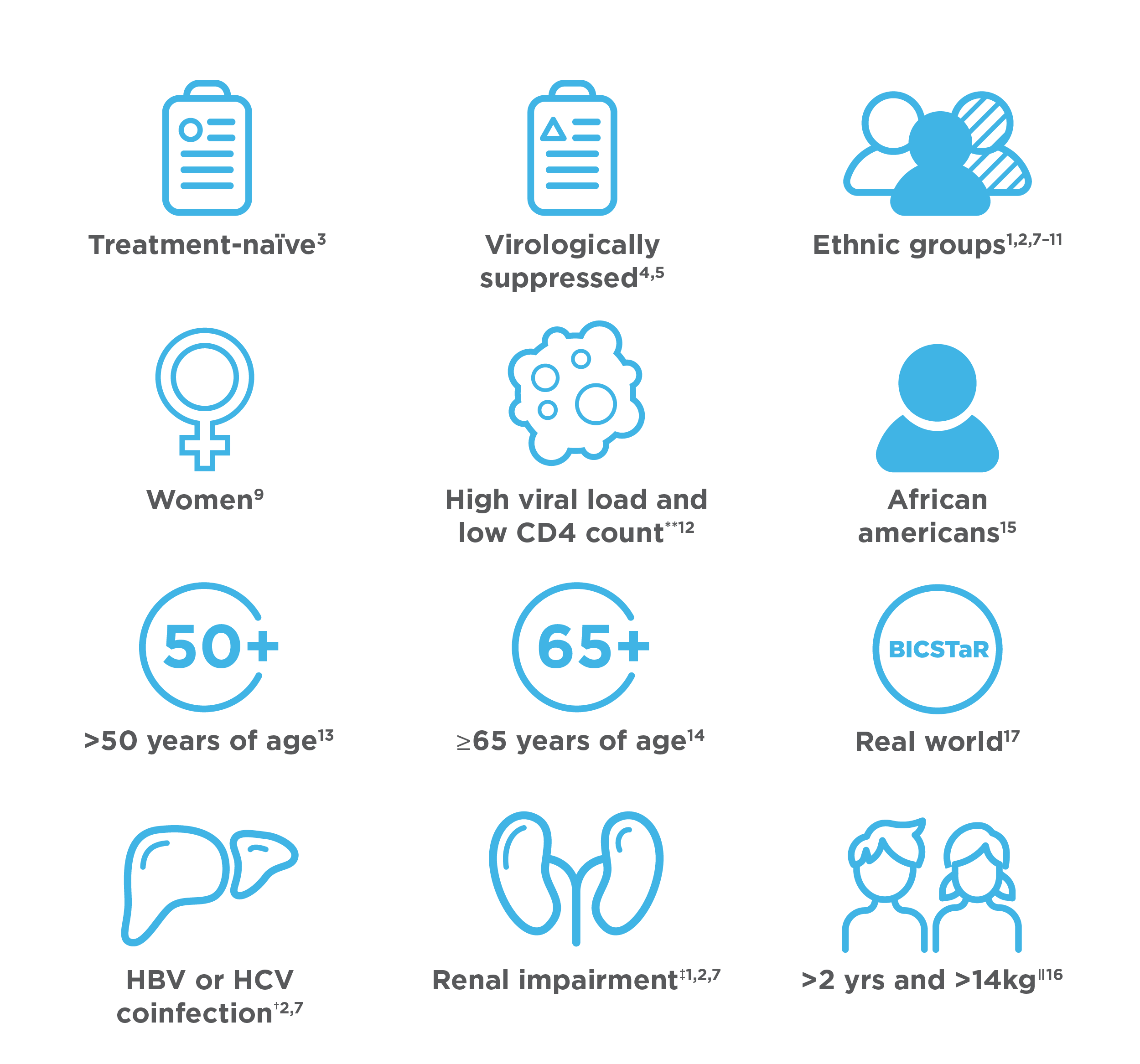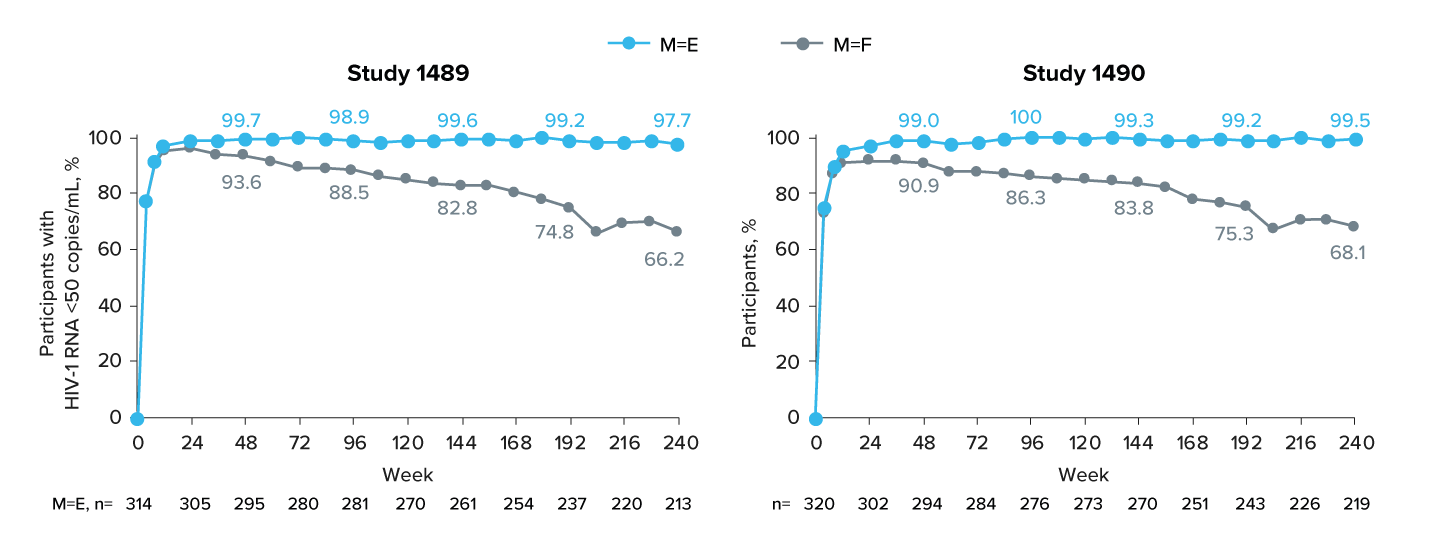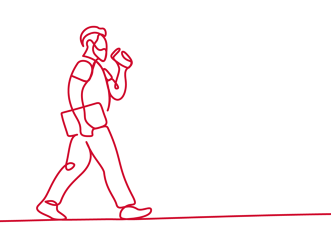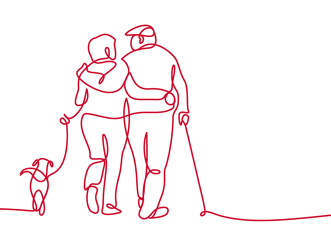Prescribe with confidence
BIKTARVY®: efficacy in a wide range of patients in clinical trials and the real world1–17
There is now over 5.1 million years of patient experience with regimens based on DESCOVY® (emtricitabine/tenofovir alafenamide 200/10 mg and 200/25 mg)18

**Baseline HIV-RNA >100,000 copies/ml and CD4 count <200 cells/μL.12
‡Nephrotoxicity: Post-marketing cases of renal impairment, including acute renal failure and proximal renal tubulopathy (PRT) reported with TAF-containing products. A potential risk of nephrotoxicity resulting from chronic exposure low tenofovir exposure with TAF cannot be excluded.
It is recommended that renal function is assessed prior to, or when initiating, TAF and is monitored during therapy in all patients as clinically appropriate. If clinically significant decreases in renal function, or evidence of PRT occur, consider discontinuation of TAF.
eGFR ≥30 ml/min, including end-stage renal disease on dialysis, if the potential benefits are judged to outweigh the risks.1,2 BIKTARVY® should generally be avoided and only be used in these patients if the potential benefits are considered to outweigh the potential risks. Initiation of BIKTARVY® should be avoided in patients with estimated creatinine clearance ≥15 mL/min and <30 mL/min or <15 mL/min who are not receiving chronic haemodialysis, as the safety of BIKTARVY® has not been established in these populations.1,2
†Patients with HIV and chronic hepatitis B (HBV) or C virus (HCV) co-infection treated with ART are at an increased risk for severe and potentially fatal hepatic adverse reactions. There are limited safety and efficacy data for BIKTARVY in patients with HIV-1 and HCV co-infection. BIKTARVY contains TAF, which is active against HBV. Discontinuation of TAF therapy in patients with HIV and HBV co-infection may be associated with severe acute exacerbations of hepatitis. Patients who discontinue TAF-based ART should be closely monitored with both clinical and laboratory follow-up for at least several months after stopping treatment.
‖Paediatric population: Reductions in bone mineral density (BMD ≥4%) of the spine and total body less head (TBLH) have been reported in patients aged between 3 to <12 years who received TAF-containing products for 48 weeks. Long-term effects of changes in BMD on the growing bone, including the risk of fracture, are uncertain. A multidisciplinary approach is recommended to decide the appropriate monitoring during treatment.
In ART naïve 1489 and 1490 studies, ≥97% efficacy (M=E analysis) after Week 48 through Week 2401,3

Study populations included ART-naïve people with HIV with HIV-1 RNA ≥ 500 c/mL. For further details on the study designs for the 1489 and 1490 studies click here
Among those with baseline CD4 <200 cells/μL from the pooled studies, 98% (49/50) had HIV-1 RNA <50 copies/mL at Week 240. Efficacy defined as viral load <50 copies/mL and was calculated using US FDA Snapshot algorithm; includes only participants initially randomised to BIKTARVY®.
Median CD4 changes from B/F/TAF start to Week 240, cells/μL (IQR): Study 1489: +313 (179, 475); Study 1490: +331 (215, 467)19,20
Zero treatment emergent resistance through 5 years of follow up in the ART naïve 1489 / 1490 studies in any group of the final resistance analysis population††3

††Final resistance analysis population included participants with confirmed HIV-1 RNA ≥200 copies/mL or ≥200 copies/mL at last visit, with no resuppression of HIV-1 RNA to <50 copies/mL while on study drug; includes only participants initially randomised to BIKTARVY®.3
You might also like
Focus on long-term health
Understand how BIKTARVY® could impact your patient's quality of life
Footnotes:
*Defined as maintained efficacy, which is dependent on patient adherence. Adherence is impacted by tolerability and simplicity of treatment.21–24
§Efficacy: In RCTs in treatment-naïve participants, BIKTARVY® was non-inferior (VL <50 copies/mL) to ABC/3TC/DTG (Study 1489) and DTG + FTC/TAF (Study 1490) at Weeks 48 (primary endpoint), 96 and 144 (secondary endpoints).1,2 Pooled efficacy for BIKTARVY® (VL <50 copies/mL, n=634, M=F) at Weeks 48 and 144 was 91% and 82% respectively.1,2 After the optional 96 week open-label extension phase (from Weeks 144 through 240), participants taking BIKTARVY® since baseline achieved and maintained high rates of virologic suppression (VL <50 copies/mL: 99% [n=426/432] M=E, 67% [n=426/634] M=F).3 In RCTs in virologically suppressed participants, BIKTARVY® was non-inferior (VL≥50 copies/mL, M=F) at the Week 48 primary endpoint to comparator regimens of ABC/3TC/DTG (Study 1844) and ATV- or DRV-based regimens (Study 1878).1,2 BIKTARVY® efficacy at Week 48 (VL <50 copies/mL, M=F) was 94% in Study 1844 (n=282) and 92% in Study 1878 (n=290).1,2 Participants who switched to BIKTARVY® at baseline or from Week 48 in an optional open-label extension (Study 1844 total exposed to BIKTARVY® n=547, Study 1878 n=534) maintained high levels of viral suppression (VL <50 copies/mL, M=E) through 96 weeks in Study 1844 (100%, n=283/283)4 and Study 1878 (100%, n=318/318).5 Resistance: In pivotal (registrational) Phase 3 RCTs, there was 0 treatment-emergent resistance to the components of BIKTARVY® in the final resistance analysis populations.1–6
ΩPivotal: defined as the four registrational trials for BIKTARVY® (Studies 1489, 1490, 1844 and 1878).
Abbreviations:
3TC, lamivudine; ABC, abacavir; ATV, atazanavir; B/FTC/TAF, bictegravir/emtricitabine/tenofovir alafenamide fumarate; CD4, cluster of differentiation 4; CI, confidence interval; DRV, darunavir; DTG, dolutegravir; eGFR; estimated glomular filtration rate; HBV, hepatitis B virus; HCV, hepatitis C virus; HIV, human immunodeficiency virus; INSTI, integrase strand transfer inhibitor; IQR, interquartile range; M=E, missing=excluded; M=F, missing=failure; NRTI, nucleoside reverse transcriptase inhibitor; RNA, ribonucleic acid; VL, viral load.
References:
- BIKTARVY® Summary of Product Characteristics (The UK).
- BIKTARVY® Summary of Product Characteristics (IE).
- Sax P, et al. eClinicalMedicine 2023;59:101991.
- Brar I, et al. Infectious Diseases (ID) Week 2020, 21–25 October. Poster 1028.
- Rockstroh JK, et al. HIV Glasgow 2020, 5–8 October; Glasgow, UK. Poster 036.
- Orkin C, et al. HIV Glasgow 2022, 23–28 October; Glasgow, UK. Poster P088.
- Gallant J, et al. Lancet 2017;390:2063–2072.
- Sax PE, et al. Lancet 2017;390:2073–2082.
- Kityo C, et al. International AIDS Society (IAS) 2019, 21–24 July; Mexico City, Mexico. Presentation MOAB0106.
- Molina JM, et al. Lancet HIV 2018;5:e357–e365.
- Daar ES, et al. Lancet HIV 2018;5:e347–e356.
- Podzamczer D, et al. HIV Glasgow 2018, 28–31 October: Glasgow, UK. Poster 119.
- Mills A, et al. Conference on Retroviruses and Opportunistic Infections (CROI) 2020, 8–11 March: Boston MA. Poster 2886.
- Maggiolo F, et al. HIV Med 2023;24:27−36.
- Hagins D, et al. J Acquir Immune Defic Syndr 2021;88:86−95.
- Natukunda E, et al. 13th International Workshop on HIV Pediatrics 2021. Virtual meeting. Available at: https://www.natap.org/2021/IAS/IAS_80.htm. Accessed February 2025.
- Trottier B, et al. HIV Glasgow 2022, 23–26 October 2022; Glasgow, UK. Poster P067.
- Gilead. Data on file HIV116. March 2022.
- Workowski K, et al. Conference on Retroviruses and Opportunistic Infections (CROI) 2021, 6–10 March. Abstract 415
- Wohl D, et al. Conference on Retroviruses and Opportunistic Infections (CROI) 2022, 12–24 February: virtual. Abstract 494.
- US Department of Health and Human Services (DHHS). What to Start: Guidelines for the Use of Antiretroviral Agents in Adults and Adolescents Living with HIV, March 2023. Available at: https://clinicalinfo.hiv.gov/sites/default/files/guidelines/documents/adult-adolescentarv/guidelines-adult-adolescent-arv.pdf. Accessed February 2025.
- Cihlar T, et al. Curr Opin Virol 2016;18:50–56.
- Trottier B, et al. J Int AIDS Soc 2014;17(Suppl 3):19765.
- Orkin C, et al. HIV Med 2018;19:18–32.
UK-BVY-0703 Date of preparation February 2025



